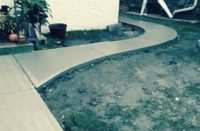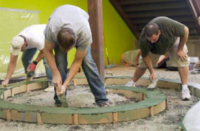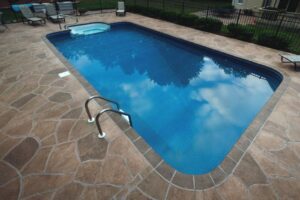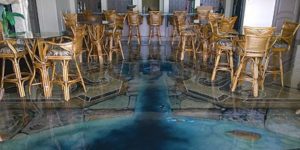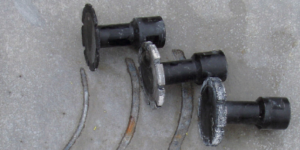 Contractors and manufacturers alike are gearing up to meet the explosive demand for decorative concrete, developing new processes, techniques and equipment to take advantage of one of the fastest-growing construction sub-markets in decades. Demand is fairly evenly split between using decorative techniques on existing and new concrete. And the same goes for both residential and commercial applications. Virtually any slab becomes a potential canvas often requiring artistic as well as mechanical skills. This lends itself greatly to introducing saw cutting concrete.
Contractors and manufacturers alike are gearing up to meet the explosive demand for decorative concrete, developing new processes, techniques and equipment to take advantage of one of the fastest-growing construction sub-markets in decades. Demand is fairly evenly split between using decorative techniques on existing and new concrete. And the same goes for both residential and commercial applications. Virtually any slab becomes a potential canvas often requiring artistic as well as mechanical skills. This lends itself greatly to introducing saw cutting concrete.
“I love to draw, I just use concrete as my medium,” says Lee Levig, president of Concrete Works in Fairfield, Calif. “And, of course, I use concrete saws and joiners instead of charcoal or brushes.
Levig says he prefers to use concrete saws when doing interior decorative work. “It gives you a cleaner line because you can grout and clean it up. But the circumstances are also a factor because usually someone has already come in and poured the slab, so any decorative work we do ends up using a self-leveling product, and the joiner really isn’t made for that type of application. Exterior work lends itself better for joiner work.”
 “A huge new trend around here right now, and I suppose in other areas of the country, is that architects are going with a really basic look,” says Steve VandeWater, managing partner of concrete contracting company ArtistiCrete, LLC, in Noblesville, IN. “This includes exposed ceiling rafters, corrugated tin, exposed ductwork and all that. To go along with this concept they are also looking for a distressed-looking floor—kind of an old warehouse look.”
“A huge new trend around here right now, and I suppose in other areas of the country, is that architects are going with a really basic look,” says Steve VandeWater, managing partner of concrete contracting company ArtistiCrete, LLC, in Noblesville, IN. “This includes exposed ceiling rafters, corrugated tin, exposed ductwork and all that. To go along with this concept they are also looking for a distressed-looking floor—kind of an old warehouse look.”
VandeWater points out the architects think they want an old warehouse look with a distressed-looking floor. In reality that would involve plain gray concrete, so instead, they incorporate color into the floor design.
“Some of them use grid patterns, such as stamped and colored brickwork, but others cut it up in odd shapes and arches in a very contemporary design,” says VandeWater. “Then they stain the various sections different colors, making it look almost like a mosaic.”
Using delineation
Using delineation on these jobs to separate the various irregular shapes and arches is preferable. Do this so that colors and stains don’t run together. The saw cuts themselves are either grouted or just left exposed, with the unstained concrete showing. The effect, says VandeWater, is almost that of a stained glass window.
A common problem when saw cutting concrete comes when a control joint runs through the design field.
 “You can incorporate control joints into your pattern if you don’t have something that’s really irregular,” says Ralph Gasser, president of Concrete By Design in Redding Calif. “For example, we’re doing a 16-foot by 40-foot patio that will be divided into 4-foot by 4-foot squares. In this case, we’ll just incorporate a sawcut joint inside one of the four-foot squares.”
“You can incorporate control joints into your pattern if you don’t have something that’s really irregular,” says Ralph Gasser, president of Concrete By Design in Redding Calif. “For example, we’re doing a 16-foot by 40-foot patio that will be divided into 4-foot by 4-foot squares. In this case, we’ll just incorporate a sawcut joint inside one of the four-foot squares.”
On diagonal patterns, Gasser says the same approach will work. He notes that one must be careful because of concrete’s propensity to take the closest route when it comes to cracking.
“But if you can penetrate that concrete fairly deeply with the sawcut, you can still work it into the pattern,” he says. “Our cosmetic sawcuts are usually about 3/8 of an inch deep at the most. For control joints, they should be a minimum of 25% the thickness of the concrete. I like to take my saw cuts for control joints down a minimum of 2 inches if I can. We find that just by using our saw cuts we’re hiding a lot of control joints in with our cosmetic work.”
“I like to use control joints as a decorative aspect of the overall project,” says Levig. “We like to cut control joints to where they have an appeal for the design. How you use the joints depends on the area you’re designing. Levig uses an example of an entrance way to a house his company recently completed. This entrance way features diamonds leading up the walk to the home’s front door.
“We were able to ‘diamond’ the control joints by putting them at a 15-degree deflection off of 90-degrees to give it a true diamond shape,” he explains. “Then we centered where the joints meet down the center of the walkway, so it’s centered to the house. That naturally draws your eye to the front door. When we do something like that, I like to border with a different color, to make the home more welcoming. We’ll do a two-pour. Usually a bold color on the outside border and we’ll center our joints to the door.
“I never try and disguise control joints — I always bring them out as part of the art,” says Levig. “If you try to disguise it, you just end up with a control joint that looks like you tried to disguise it. I like angles because it makes it much easier to add the control joint as part of the art. Cutting joints by hand minimizes the chance of the slab cracking before you can get a saw into it. We like to use a “torpedo groover” for the initial cutting because it cuts nice and straight. It aslo has a deep blade. With random stone texture mats, we like to saw cut after we’re done. This is because the nature of the mat can’t really make the joint part of your pattern.”
“I would rather see a slab that’s going to be 20X20 feet broken up into squares and stained than try to take that same slab and create rocks on it, because the rocks are going to have a texture to them,” says Gasser. “It’s not that it can’t be done. You just have to make sure the customer knows how it’s going to turn out.”
 As contractors develop more and more techniques for decorative concrete work, manufacturers try to match that by developing more progressive equipment, according to Darrel Adamson, president of Engrave-a-Crete in Sarasota, Fla. His decorative concrete grooving and engraving equipment has been cutting circular and straight patterns in bricks, tiles and cobblestone, as well as concrete, since 1991.
As contractors develop more and more techniques for decorative concrete work, manufacturers try to match that by developing more progressive equipment, according to Darrel Adamson, president of Engrave-a-Crete in Sarasota, Fla. His decorative concrete grooving and engraving equipment has been cutting circular and straight patterns in bricks, tiles and cobblestone, as well as concrete, since 1991.
“We’ve seen a great deal of growth toward more and more decorative concrete work. We’ve been coming up with new tools accordingly,” says Adamson. “Our new Mochton stylus engraving system can do things such as cut intricate Celtic knots into concrete slabs. It can even cut a life-size figure from a photograph.”
Adamson says the Mochton stylus engraving system cuts the pattern into the concrete quicker than is possible with the other tools currently on the market. The new system typically cuts patterns the thickness of about two pennies into stained or colored concrete. They then fill the cuts flush with the rest of the floor using colored grout on epoxy. But the grooves are usually left as is. This gives the appearance of mortar joints.
Frank Piccolo is president of ArtCrete, Inc. in Natchitoches, Louisiana. Piccolo says, “you used to have to hire specialty contractors to do the decorative work on your jobs,” says Piccolo. “Today, if you do concrete, you’ve got to be able to do some specialty work as part of your skills. I’m giving it between five and fifteen years until it comes to the point where all concrete businesses will be doing some kind of decorative work.”
 And this kind of work requires knowledge not only of coloring, stamping and staining, but also of sawing concrete in order to delineate the various areas. For instance, using delineation to separate an area of textured concrete from that of a smooth, troweled finish, exposed aggregate from a smooth finish. It also helps to separate areas of different colors.
And this kind of work requires knowledge not only of coloring, stamping and staining, but also of sawing concrete in order to delineate the various areas. For instance, using delineation to separate an area of textured concrete from that of a smooth, troweled finish, exposed aggregate from a smooth finish. It also helps to separate areas of different colors.
Lines and curves
The lion’s share of delineation work, however, consists of straight lines and gentle curves. This may not be sexy, but aesthetically, it is very pleasing and functional. And here again, manufacturers are busy building better mousetraps in order to make the concrete contractor’s life a little easier.
Take, for example, the patented Harris Accu-Glide Saw, manufactured by Star Diamond Tools, Inc., Delta, British Columbia.
“As more and more delineation is used in decorative concrete work, there becomes an increasing emphasis on speed,” says John Bernat, president of Star Diamond Tools. “However, sacrificing very precise, controlled sawing for speed is a no-no. Hand-held methods are time-consuming, and long, perfectly straight lines are very hard to achieve.”
Bernat says his company saw their niche in with a specific machine. The machine allowed contractors to easily cut a perfectly straight line when delineating concrete.
 “We identified that simple concept as being extremely important because when delineating geometric patterns, all the squares and all the patterns have to come in and meet at 90-degree angles,” he says. “If any of the lines are off, the job looks terrible.”
“We identified that simple concept as being extremely important because when delineating geometric patterns, all the squares and all the patterns have to come in and meet at 90-degree angles,” he says. “If any of the lines are off, the job looks terrible.”
“Another major advantage of the saw is that it doesn’t take a skilled operator to use it,” points out Bernat. “Decorative concrete is an art form, and the typical laborer won’t be as skilled at it as the contractor. With this saw, the laborer can work on the delineation while the contractor works on more intricate aspects of the project.”
With or without special equipment, Bob Williams, director of marketing for StampCrete International, Ltd. in Liverpool, NY, says concrete contractors needn’t shy away from work involving delineation.
“Saw cutting is easy,” he says. “It doesn’t take any higher degree of skill than any other type of concrete work a contractor has done. Most the time it just consists of running a straight line. Since you’re not going that deep into the surface, it’s not all that much work.”
This is very true since concrete contractors are already intimately familiar with the medium they work with daily. Contractors need to follow the basic rules of concrete while developing the creative techniques and skills involved in saw cutting concrete.
